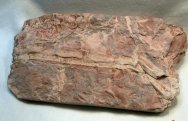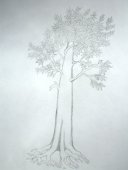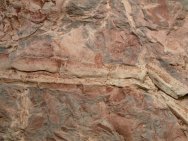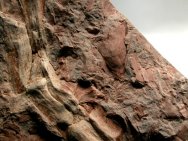Vertebraria
indica, Nummulospermum bowense
Geologic
Time: Late Permian, Tatarian Stage
Size (25.4
mm = 1 inch): Vertebraria: 115 mm long by 12 mm across Nummulospermum:
14 mm by 7 mm on a 115 mm by 65 mm long matrix
Fossil Site:
Newcastle Coal Measures, Caves Beach, New South Wales, Australia
Fossil Code:
AFF477
Price: Sold
 Description:
Glossopteris leaves are a widespread fossil, but are difficult to
assign by species because of the wide variety of venation patterns
and morphology. They are found throughout what was once Gondwana,
another support for continental drift. The genus derives its name
from the Greek words for tongue and fern. Description:
Glossopteris leaves are a widespread fossil, but are difficult to
assign by species because of the wide variety of venation patterns
and morphology. They are found throughout what was once Gondwana,
another support for continental drift. The genus derives its name
from the Greek words for tongue and fern.  They
favored a swampy habitat, and some had leaves up to a meter in length.
The leaves have only rarely ever been found attached to branches,
but the restoration here is of one that had a tree-like habit. Few
Glossopteris leaves have been found in strata younger than the Permian,
a time that closed with the greatest of all mass extinctions on
the planet. What is preserved here is a portion of the root system
known as Vertebraria due to its resemblance to the backbone of an
animal. The segmentation is believed to have performed an aerating
function for the plant in its swampy habitat, allowing the plant
to breathe. Additionally, a seed of a Glossopterid known as Nummulospermum
is also present, making for a most unusual pair. They
favored a swampy habitat, and some had leaves up to a meter in length.
The leaves have only rarely ever been found attached to branches,
but the restoration here is of one that had a tree-like habit. Few
Glossopteris leaves have been found in strata younger than the Permian,
a time that closed with the greatest of all mass extinctions on
the planet. What is preserved here is a portion of the root system
known as Vertebraria due to its resemblance to the backbone of an
animal. The segmentation is believed to have performed an aerating
function for the plant in its swampy habitat, allowing the plant
to breathe. Additionally, a seed of a Glossopterid known as Nummulospermum
is also present, making for a most unusual pair.
|
|




